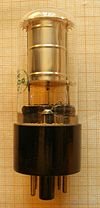This term has other meanings, see Zener diode (meanings).
Glow discharge stabilizer is an ionic gas-discharge electrovacuum device designed to stabilize the voltage. Glow discharge zener diodes are filled with a mixture of inert gases and are designed to stabilize voltages from 80 V (argon-helium ineon-krypton mixture) to 1.2 kV (helium-neon mixture). Structurally close zener diodes of the corona discharge are filled with hydrogen and are intended to stabilize voltages from 0.4 to tens of kV.
Content
- 1 principle of operation
- 2 Basic parameters and their typical values
- 3 Marking of zener diodes in the USSR
- 4 Application
- 5 Features of use
- 6 Literature
- 7 References
Operating principle
The work of the Zener diode is based on the property of a glow discharge when changing the current through the device does not change the voltage drop between the electrodes. Structurally, the Zener diode consists of 2 coaxial electrodes (the cathode is usually outside), placed in a glass or metal cylinder containing a mixture of gases (usually inert) at a pressure of tens of mm Hg. Art. An increase in current during a glow discharge with such an arrangement of electrodes occurs due to an increase in the cathode area covered by the discharge, while the current density in the ionized part of the gas remains unchanged, therefore, the voltage drop across the discharge gap remains unchanged. In some cases, to reduce the ignition voltage, a small amount of a radioactive substance is introduced into the device [1] .
Basic parameters and their typical values
- U stabilization (70 ... 1400 volts)
- U ignition (more than about U stabilization by about 20-40%)
- I stabilization (from microamps to tens of milliamperes; the ratio of the minimum operating current to the maximum from 1: 4 to 1:10)
- R internal (hundreds of ohms)
- Voltage variation of stabilization with current variation in the operating range (units of volts for low-voltage zener diodes)
- The change in voltage stabilization over time (tenths of a volt for low-voltage zener diodes)
- Temperature coefficient of voltage (tens [2] mV / ° C, for both low-voltage and high-voltage devices [ source not specified 236 days ] )
Marking of zener diodes in the USSR
- SG - Zener Gas [3]
- number - serial number of the device
- letter - constructive design
- the letter "B" - if there is, then it indicates vibration resistance
Example: SG204K.
Application
Before the advent of semiconductor zener diodes were used as:
- parametric voltage regulators (with a relatively low-power load).
- reference voltage sources in voltage regulators, measuring equipment
- level shifters in DC lamp amplifiers
Currently used in industrial equipment where it is necessary to obtain a high stable voltage (for example, in dosimeters (radiometers); some Zener diodes, for example, SG301S were specially designed to work with 400-volt Geiger counters, such as the SBM-20).
Features of use
- Zener diodes are designed to work in DC circuits. It is not allowed to apply alternating or reverse DC voltage to the Zener diode.
- It is desirable that the voltage of the power source was 10-20% higher than the voltage of occurrence of the discharge. Otherwise, there may be delays with the inclusion of the Zener diode.
- The power supply, the load and the Zener diode itself must be matched by current and voltage so that the current of the Zener diode in any conditions (including when the load is disconnected) is within the normal range.
- In the event of a current break through the Zener diode, the voltage across the load may exceed the permissible threshold. In some Zener diodes, an additional protective jumper is provided: if the lamp is removed from the connector, the load is disconnected from the power source.
- It is unacceptable to connect filter tanks in parallel with the zener diode. Like all devices with hysteresis, a gas-discharge zener diode in conjunction with a high-resistance power source and capacitance can generate parasitic auto-radiation ***.

Comments
To leave a comment
Radio tubes and ion devices
Terms: Radio tubes and ion devices